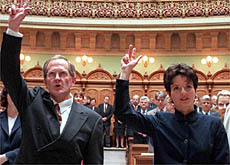Swiss ministers not easily unseated

The Swiss People’s Party’s is launching a fresh attempt to get a second seat in government by ousting a cabinet minister.
If the rightwing party is successful, it will be only the third time an existing member of the Swiss government has not been re-elected.
Under the Swiss political system, there is no provision for a parliamentary no-confidence motion, or for the dissolution of parliament before it has run its term.
Cabinet ministers can only be unseated when they stand for re-election every four years at the beginning of a new legislature.
Planned resignations
The last time the People’s Party tried to get rid of a member of the government was in 1999.
The party’s official candidate then – as now – was its controversial driving force, Christoph Blocher.
He stood against the two incumbent centre-left Social Democrat ministers, Ruth Dreifuss and Mortitz Leuenberger, but was easily defeated.
While attempts to unseat ministers have been very few and far between, there have been planned resignations to secure a political advantage ahead of parliamentary elections.
The most blatant case was that of the two Christian Democrat ministers in 1999 – Arnold Koller and Flavio Cotti. They both resigned six months before the elections, allowing their successors – Joseph Deiss and Ruth Metzler – time to settle in to their new jobs.
Scandal
The careers of two government members have been cut short by political scandals.
In 1966 the reputation of the centre-right Radical Party’s Paul Chaudet, the defence minister at the time, was ruined by the “Mirage affair”, when expenditure on fighter planes went grossly over budget.
The Radicals decided not to put him forward as a candidate for the vice-presidency of the Confederation, fearing negative repercussions in the parliamentary elections of 1967. Chaudet resigned in a fit of pique.
Another Radical, Elisabeth Kopp, actually resigned twice. In December 1988, she admitted having warned her husband of a criminal investigation into a company of which he was vice-chairman and tendered her resignation for 28 February 1989.
She then resigned with immediate effect on 12 January 1989, when the conclusions of a report accused her of having violated official secrecy.
Forced resignations
In the twentieth century, there were two cases of cabinet ministers being forced to resign.
In 1917, the Radical Party’s Arthur Hoffmann was obliged to resign to protect Swiss neutrality, after he made private moves to secure a separate peace between Germany and Russia.
Foreign policy considerations also led to the resignation of another Radical, Marcel Pilet-Golaz, in 1944.
He was regarded as too close to the Axis powers, and as Switzerland’s man in charge of foreign affairs, he had become an obstacle to the normalisation of relations with the Soviet Union.
Political defeats
Two resignations have been occasioned by political defeats. In 1934 Heinrich Häberlin of the Radical Party resigned when the electorate refused to approve a law on state security.
Social Democrat Max Weber also chose the same course of action in 1953 when his financial reform plans were rejected.
And then there was the case in 1934 of Jean-Marie Musy.
He stepped down from office unexpectedly after failing to persuade all his government colleagues to resign with him. It is assumed that Musy, a Christian Democrat with extreme-right connections, wanted to bring about a political and institutional crisis.
Voted out
The only two cases of a sitting cabinet minister failing to be re-elected both occurred over a century ago.
In 1854 the Radical Party’s Ulrich Ochsenbein was voted out of office. His party no longer considered him trustworthy.
Another Radical, Jean-Jacques Challet-Venel, paid for his opposition to the party’s constitutional reform plans in 1872, when he failed to secure re-election.
During the period when Radical Party’s commanded an absolute majority in parliament, failure to be reconfirmed in office was just one of the normal hazards of the system.
Things changed at the end of the nineteenth century, when structured parliamentary groups were formed and the Catholic-Conservatives, the forerunners of the Christian Democrats, became part of the government.
No party has held an absolute majority in parliament since 1919, when proportional representation was adopted to elect members of the House of Representatives.
With no one party holding a majority, making a challenge to unseat a cabinet minister who wants to stay put has become more difficult.
swissinfo, Marco Marcacci
Every four years, just after parliamentary elections, government ministers who wish to remain in office have to seek a renewed mandate from parliament.
Under the Swiss political system, it is not possible to get rid of a minister by means of a no-confidence vote.
The possibility of sacking one or more members of the executive has been provided for in the Federal Constitution since 1848.

In compliance with the JTI standards
More: SWI swissinfo.ch certified by the Journalism Trust Initiative











You can find an overview of ongoing debates with our journalists here . Please join us!
If you want to start a conversation about a topic raised in this article or want to report factual errors, email us at english@swissinfo.ch.